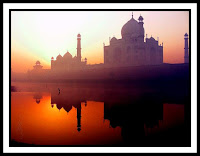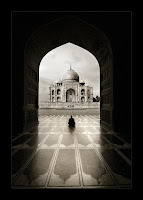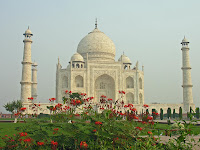Taj Mahal
If the plan to close the Taj Mahal goes into effect, it would reduce this over-the-top mausoleum — built by Shah Jahan (fifth emperor of the Mughal dynasty) to mourn his favorite wife, Mumtaz Mahal — to a mere postcard silhouette instead of the spiritual experience it can be.
Even a recent rise in admission prices doesn't deter floods of tourists from shuffling through the Taj Maha l — three to four million tourists every year. Between the crowds and the air pollution that's eating away its white stone facade, tourism officials are considering closing this 17th-century landmark to the public, leaving its fabulous domed symmetry — that graceful center onion dome, the four smaller surrounding domes, the slender punctuating minarets, the serene reflecting pool — visible only from afar.
Shah Jahan placed this memorial beside the Yamuna River, despite the constant risk of flooding, because it was next to the bustling market of the Tajganj, where it is said he first saw Mumtaz selling jewels in a market stall. Work started in 1641, and it took 20,000 laborers (not to mention oxen and elephants) 22 years to complete; its marble came from Rajasthan, the precious stones from all over Asia. In the late 19th century, the badly deteriorated Taj Mahal was extensively restored by British viceroy Lord Curzon; what will today's Indian government do to preserve this treasure?
Click to enlarge pictures (Open in new window)
More Places to See Before They Disappear
Even a recent rise in admission prices doesn't deter floods of tourists from shuffling through the Taj Maha l — three to four million tourists every year. Between the crowds and the air pollution that's eating away its white stone facade, tourism officials are considering closing this 17th-century landmark to the public, leaving its fabulous domed symmetry — that graceful center onion dome, the four smaller surrounding domes, the slender punctuating minarets, the serene reflecting pool — visible only from afar.
Shah Jahan placed this memorial beside the Yamuna River, despite the constant risk of flooding, because it was next to the bustling market of the Tajganj, where it is said he first saw Mumtaz selling jewels in a market stall. Work started in 1641, and it took 20,000 laborers (not to mention oxen and elephants) 22 years to complete; its marble came from Rajasthan, the precious stones from all over Asia. In the late 19th century, the badly deteriorated Taj Mahal was extensively restored by British viceroy Lord Curzon; what will today's Indian government do to preserve this treasure?
Click to enlarge pictures (Open in new window)
More Places to See Before They Disappear









1 comment:
Thanks for information.
Post a Comment